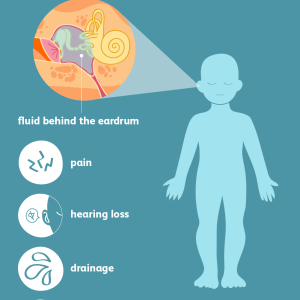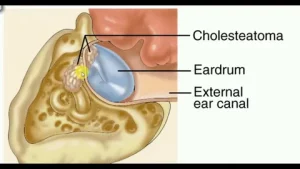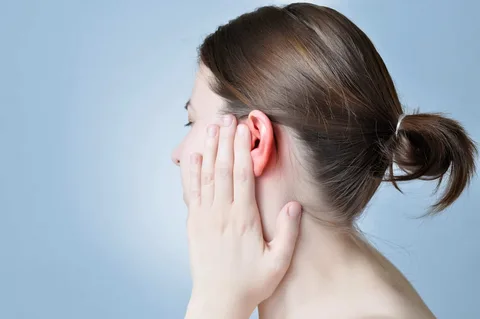
Introduction
Middle ear infections, medically termed otitis media, stand as a prevalent concern affecting individuals across various age groups, with a pronounced impact on children. This comprehensive guide aspires to provide an exhaustive exploration, offering a deep dive into the multifaceted nature of middle ear infections. From deciphering their root causes to unraveling intricate symptoms, understanding diverse treatment approaches, and embracing preventive strategies, this guide aims to equip readers with an encompassing knowledge base.
Symptoms and Signs
- Earache:
- Common symptom indicating inflammation and infection in the middle ear.
- Fever:
- Elevated body temperature often accompanies middle ear infections.
- Vomiting:
- Some individuals, especially children, may experience vomiting as a response to the infection.
- Fatigue:
- A general lack of energy is a prevalent symptom during a middle ear infection.
- Hearing Loss:
- Fluid accumulation in the middle ear can lead to slight hearing loss, particularly if the condition persists.

When to Seek Medical Advice
- While many cases may resolve spontaneously, persistent symptoms demand vigilant medical attention.
- Consulting a healthcare professional is crucial if symptoms exhibit no improvement after a conservative timeframe of two to three days.
- The significance of seeking advice amplifies when confronted with persistent pain, discharge, or the presence of an underlying health condition.
Causes of Middle Ear Infections
- Infections, often originating from respiratory ailments like colds, pave the way for mucus buildup within the middle ear.
- The Eustachian tube, responsible for drainage, may succumb to swelling or blockage, impeding the fluid drainage process.
- Enlarged adenoids, prevalent in children, further contribute to Eustachian tube blockage, elevating susceptibility.

Prevention Tips
- Strategic vaccination adherence, particularly emphasizing essential shots such as the pneumococcal and DTaP/IPV/Hib/HepB vaccines, plays a pivotal role.
- Mitigating exposure to smoky environments emerges as a preventive measure to curtail infection risks.
- Embracing breastfeeding, adhering to appropriate feeding positions, and judiciously limiting contact with unwell children collectively constitute a robust preventive approach.
Complications and Further Problems
Mastoiditis:
Symptoms: High fever, swelling behind the ear, redness, tenderness, creamy discharge.
Treatment: Typically involves antibiotics administered intravenously; surgery may be necessary to drain the infected mastoid bone.
Cholesteatoma:
Symptoms: Hearing loss, weakness in half the face, dizziness, tinnitus.
Treatment: Surgical removal is often required to prevent damage to delicate ear structures.
Labyrinthitis:
Symptoms: Dizziness, vertigo, loss of balance, hearing loss.
Treatment: Symptoms usually resolve within weeks; medication may be prescribed to alleviate symptoms and address the underlying infection.
Speech and Language Development Issues:
Risk: Frequent ear infections in early childhood may impact speech and language development.
Action: Consult a GP if concerned about a child’s development; early intervention may be necessary.
Facial Paralysis:
Cause: Swelling associated with otitis media can compress the facial nerve.
Outcome: Temporary facial paralysis; resolves as the infection subsides, rarely causing long-term problems.
Meningitis:
Symptoms: Severe headache, vomiting, high fever, stiff neck, sensitivity to light.
Treatment: Urgent hospitalization and intravenous antibiotics; requires prompt medical attention.
Brain Abscess:
Symptoms: Severe headache, changes in mental state, weakness or paralysis, seizures.
Treatment: Combination of antibiotics and surgery to drain pus from the abscess or remove it entirely; requires immediate medical intervention.

Diagnosing Middle Ear Infections
- Otoscope Examination: A standard diagnostic method involves using an otoscope, a handheld device with a magnifying glass and light, to inspect the ear canal and eardrum for signs such as bulging, unusual color, or a cloudy appearance.
- Tympanometry Test: This test measures how the eardrum reacts to changes in air pressure. A probe is inserted into the ear, and changes in air pressure are induced while transmitting sound. The device records the eardrum’s movement, helping identify fluid behind it.
- Audiometry: Employing an audiometer, this hearing test assesses if the infection has led to any hearing loss. The individual listens through headphones to sounds of varying volume and frequency, providing insights into the extent of potential hearing impairment.
- Further Tests if Needed: In cases where initial diagnostics don’t suffice or complications arise, additional tests may be conducted at an Ear, Nose, and Throat (ENT) department. These may include more detailed scans like CT or MRI scans.
- Monitoring Eardrum Movement: Some otoscopes can blow a small puff of air into the ear to check for blockages in the middle ear. If the Eustachian tube is clear, the eardrum should move slightly; if blocked, the eardrum remains still, indicating a potential infection.
Treatment Options
- A considerable proportion of middle ear infections spontaneously resolve within a timeframe of 3-5 days, obviating the necessity for specific treatment.
- Antibiotics, not routinely prescribed, yield precedence to pain relief measures in managing symptoms.
- For children grappling with recurrent severe infections, the insertion of grommets, diminutive tubes facilitating fluid drainage, emerges as a potential intervention.

Grommets and Complications
- Grommets, delicately inserted into the eardrum, offer a solution for recurrent infections, particularly in children.
- While complications associated with grommets, such as mastoiditis, cholesteatoma, and facial paralysis, remain infrequent, their recognition necessitates immediate medical intervention.
- The proactive management of complications is pivotal in averting potential long-term consequences.
Conclusion
Traversing the expansive landscape of middle ear infections demands not merely a cursory understanding but an immersive exploration of their nuances. Recognizing symptoms, discerning the opportune moment to seek medical advice, and conscientiously adopting preventive measures collectively contribute to the endeavor of maintaining ear health, not just in children but across diverse age groups. Arm yourself with comprehensive knowledge for a resilient, infection-resistant auditory system that stands the test of time.










